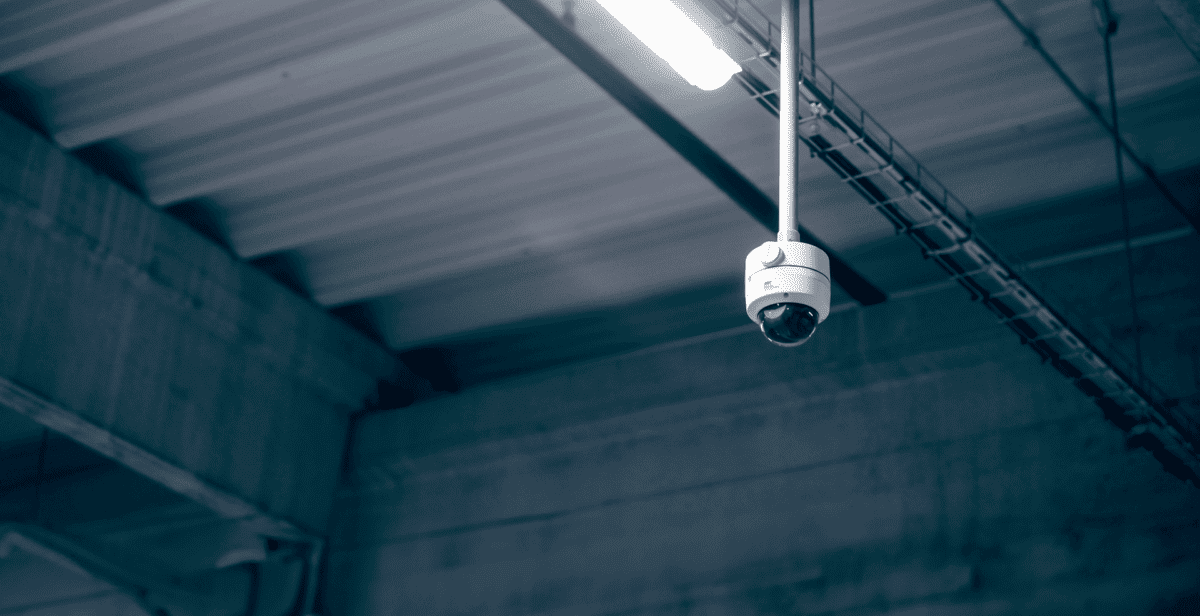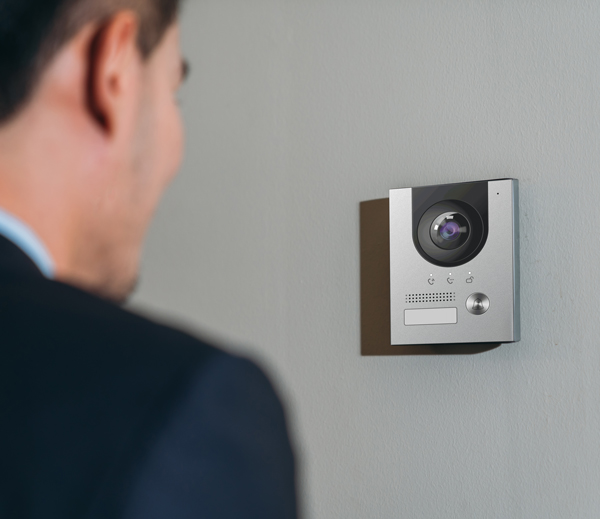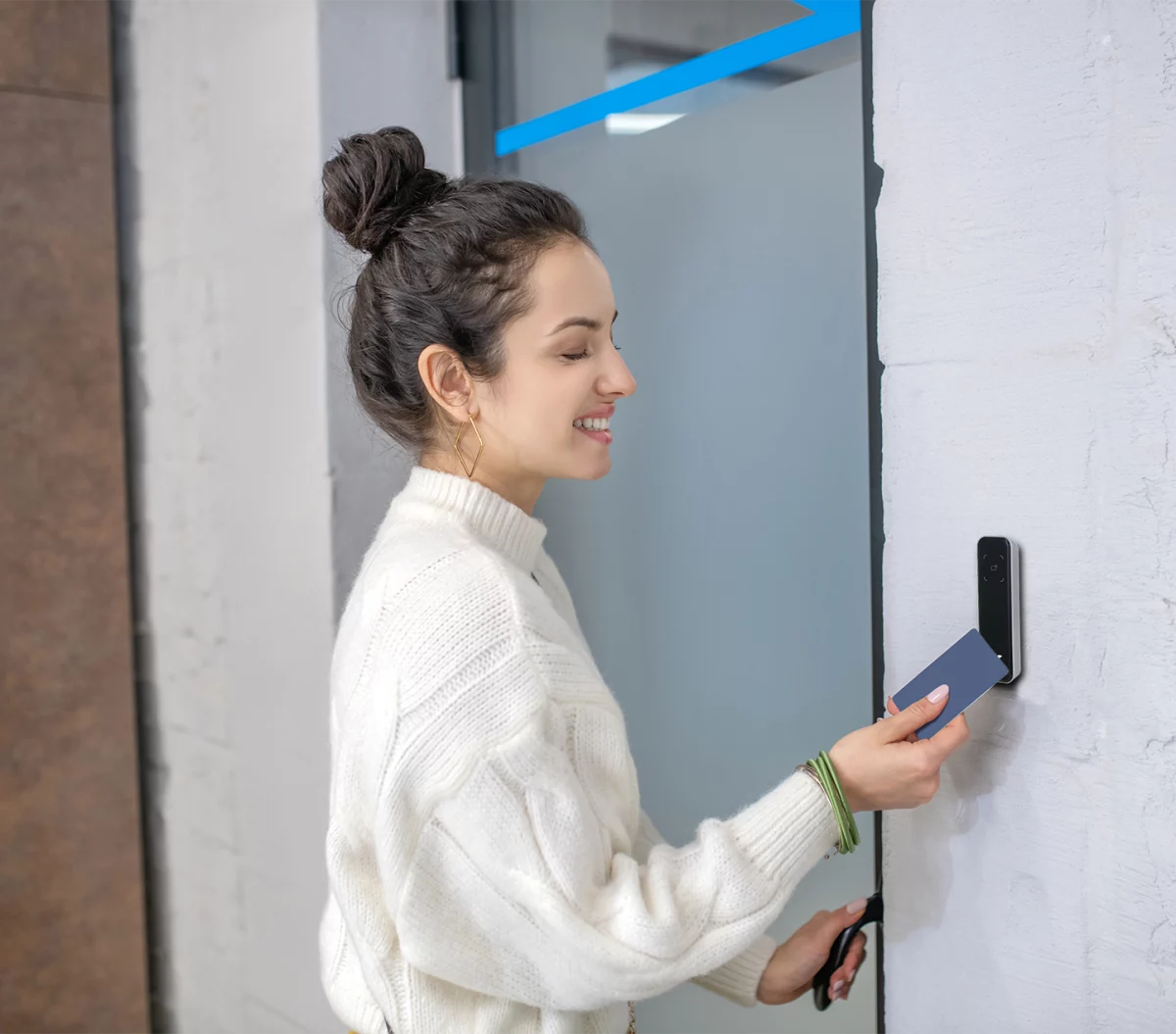
What Is Facial Recognition?
Discover more about the fastest growing biometric technology
Facial recognition is a relatively new biometric technology that was once the stuff of science fiction, but this groundbreaking technology is rapidly evolving, especially in the wake of the global pandemic and AI. The crisis acted as a catalyst, accelerating the adoption of facial recognition access control using face scanners across various sectors—from healthcare to retail, and even in smart cities due to its contactless nature.
As businesses strive for greater efficiency and security combined with a better user experience, the technology has moved from being a novel concept to an integral part of organisational strategy. If you’ve ever wondered about the capabilities, applications, and ethical considerations of facial recognition, you’ve come to the right place.
Is Facial Recognition Secure?
Facial recognition access control matches a face’s characteristics against a template in a database. These 3D facial details such as the eyes, the nose structure and the shape of the chin are converted into a mathematical representation and then collected into a face recognition database.
Enrolment
The facial template must have been enrolled in the database first, then a matching process follows where identifying points are verified against the authorised biometric template. These templates are different to photographs because they are designed to only include particular details that help to distinguish one person’s face from another.
Biometric Template
The data is stored as a biometric template, rather than a picture of your face. In Almas solutions data is encrypted using 256bit encryption. Essentially a hacker would require 2256 different combinations to break a 256-bit encrypted message, which is a huge challenge even for the fastest computers. If they were trying to steal your identity, they would find it far, far easier to lift an image from your social media than to break into the database with your facial biometric template and backwards engineer it to a photo.
What’s the difference between facial recognition and facial detection?
Facial Detection and AI
Facial detection merely identifies that something is a face – with some CCTV camera systems the view can then zoom in to see the face in more detail. With the advent of AI in CCTV, there is now technology that will identify attributes and intent through facial analysis – this could be that a person is female, a rough age, whether they are angry or scared and more. But that still isn’t recognising that person as a defined individual. What AI can do now, is then track that person through recorded footage and then pick them up again on different cameras – this is useful technology when a crime has been committed as the police can trace a suspect’s movements.
Facial Recognition
This term implies trying to identify specifically whose face it is. Normally by comparison with a database. For private organisations, this database would consist of enrolled facial templates given when new users are added, with their consent, to a closed system. In good quality systems data templates are encrypted and are not shared outside the system. You can read a more in-depth answer and some myths being debunked in our article – Facial Recognition – A Clearer Picture
Is Facial Recognition Inaccurate When Identifying People?
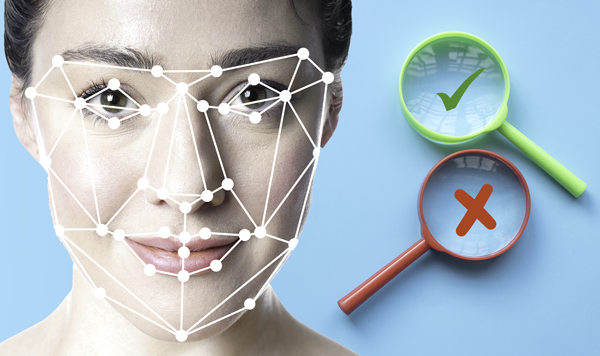 As with any technology, not all systems are created equal. In the studies conducted by NIST, while some of the algorithms tested only had a 70% accuracy rate, or had problems identifying women or those from ethnic minorities (you can read more about this below), the best achieved accuracy of over 99.8% across all demographics. The institute anticipates that this will improve yet further as researchers expand and refine the datasets used by the deep-learning technology.
As with any technology, not all systems are created equal. In the studies conducted by NIST, while some of the algorithms tested only had a 70% accuracy rate, or had problems identifying women or those from ethnic minorities (you can read more about this below), the best achieved accuracy of over 99.8% across all demographics. The institute anticipates that this will improve yet further as researchers expand and refine the datasets used by the deep-learning technology.
External Factors Affecting Accuracy
It’s worth mentioning, however, that the success and accuracy of any facial recognition access control system are dependent on how it is used and where it is located. The camera will need to clearly see the face presented for verification, so good lighting is important. Factors including external weather conditions, height of reader, distance set for reading the face, changing facial features can all affect the error rate. Similarly, it should be positioned in such a way that accidental verification does not take place from someone passing behind.
Are Facial Recognition Systems Linked To Authorities?
While some public CCTV systems may have had facial recognition tied in to them as part of a trial for identification (such as in South Wales), it was deemed that there is currently insufficient legal and policy framework for this to be permitted after Ed Bridges successfully sued South Wales police. They were using live recognition – that is using cameras in real time such as at events to scan faces and match them against a database of known offenders. The court deemed that as the data subjects had not been given the option to consent (or not), that it breached their rights under GDPR.
The Met are continuing to press on using facial recognition as are some other police services, there has recently been a resurgence in proposals to use facial recognition to combat rising shoplifting and assaults in the retail sector.
In Ireland, the Government is committed to giving the An Garda Síochána the tools they need to fight crime efficiently. There are plans to introduce facial recognition technology in evidence checking – that is after a crime has been committed and in a limited way. Although there are plans to bring in body cameras for the Garda, it doesn’t seem that they will be embracing live recognition any time soon. It’s certainly an emotive subject and is provoking many interesting discussions on the legitimacy and scope of using facial recognition in the fight against crime.
When it comes to access control and verification as you might use within your company, all data is stored locally and securely, and is not linked to any national databases – but it is feasible if a crime is committed that the police could ask for access to records generated by the use of your biometric template – although not the template itself.
Is Facial Recognition Slow?
Early versions of the technology may have struggled to correctly identify subjects in a timely manner, but cameras and computers have improved over the last 10 years. It can also depend on the method of authentication, if it’s matching 1 to many and there are 10,000 faces on the system then some technology could struggle.
Almas Industries’ face scanners can accurately detect and identify a face in less than 0.2s.
Can facial recognition be used to steal your identity?
While the advantage of biometrics for identification such as facial or fingerprint is clear, it’s completely understandable that people are concerned about the security of this information.
Last year, the BBC reported that a biometric security company was successfully hacked by cyber-security researchers. The ethical hackers had been able to convert around half a dozen samples of data using the company’s software to recreate visible fingerprint patterns.
No system is foolproof though and really determined hackers may be able to find a way, but on most commercial sites, it’s much more secure than traditional access control methods and less likely to be compromised.
Using our fingerprint or facial recognition scanners, at no point is an image of your fingerprint/ face retained other than in the enrolment process. Focussing on the minutiae of your finger or unique points on your face, this scan is used to create a digital, mathematical, biometric template, which is then securely encrypted. While the template can verify that you are who you say you are, it cannot be used to recreate your fingerprint or face scan.
Will facial recognition replace passwords in the future?
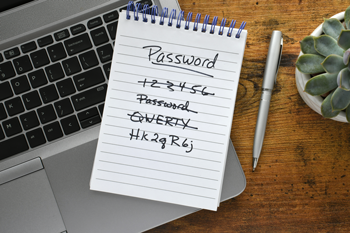 Passwords have been around for many years as one on the primary methods we use for security. The problem is that they are easy to forget, often easy to guess if they are not complex (and who really chooses a complex password unless it’s being saved on your computer) and difficult to remember over the hundred of other passwords we can have. Facial recognition on the other hand is extremely secure as a person’s facial structure is unique and can only be granted access if the the original facial template has been matched.
Passwords have been around for many years as one on the primary methods we use for security. The problem is that they are easy to forget, often easy to guess if they are not complex (and who really chooses a complex password unless it’s being saved on your computer) and difficult to remember over the hundred of other passwords we can have. Facial recognition on the other hand is extremely secure as a person’s facial structure is unique and can only be granted access if the the original facial template has been matched.
Whilst facial recognition is more secure, the question of whether or not it will be come to replace passwords as the primary method of gatekeeping is still a debate as its use is still relatively new. It is unlikely, however, that passwords will be entirely replaced by facial recognition in the near future.
Is Facial Recognition Covered By GDPR?
Yes absolutely, 100%, any facial template that is created through companies using biometric access control is covered under the GDPR (General Data Protection Regulation) and UK GDPR. This means that the collection, storage, use and retention of the data must be carefully thought through. A PIA (privacy impact assessment) should be undertaken to ascertain whether it is a reasonable impingement of a person’s right to privacy. When considering implement a facial recognition access control or time and attendance system, it’s vital that your users understand why you’re implementing it, how it will benefit them and that their data is secure. They should also be given the option to use a different authentication method if they object. Good communication is key.

Facial Recognition Access Control: +ves and -ves
The Positives of Facial Recognition Access Control
- Enhanced Security: Unlike traditional methods, facial features are unique and cannot be easily replicated, offering a higher level of security.
- Quick and Efficient: Facial scans take mere seconds, streamlining the access process and improving operational efficiency.
- Non-Intrusive: No physical contact is required, making it a hygienic option, especially important in the current health-conscious environment.
- Easy Integration: Can be easily integrated into existing security systems, offering a seamless transition and operational continuity.
- User-Friendly: Requires minimal training for staff, ensuring a smooth adoption process across the organisation.
- Data Analytics: Capable of generating valuable data for attendance, time tracking, and even customer behaviour in retail settings.
The Negatives of Facial Recognition Access Control
- Privacy Concerns: The collection of biometric data can raise ethical and privacy issues that businesses need to address.
- Initial Cost: The upfront investment for advanced facial recognition systems can be high, although it pays off in the long run.
- False Positives/ Negatives: While rare, the technology is not entirely foolproof and can sometimes either deny legitimate access or grant unauthorised access.
- Environmental Factors: Factors like poor lighting, rain or changes in facial features (e.g., facial hair, glasses) can sometimes affect the system’s accuracy.
- Data Storage and Security: The biometric data needs to be stored securely to prevent any potential breaches, requiring additional cybersecurity measures.
Can Facial Recognition Access Control Be Used For Children?
Under the GDPR there is a special category of ‘vulnerable data subjects’, children and vulnerable adults fall into this category because circumstances may restrict their ability to freely consent or object to the processing of their personal data, or to understand its implications. You must undertake a Data Protection Impact Assessment to help you identify and systematically analyse, identify and minimise the data protection risks of a project or plan. Generally for young children we wouldn’t recommend it unless it was for specific safeguarding reasons. For teenagers approaching majority, it could be argued that they can understand and consent and it could improve security. You really have to delve into why you feel it’s the most appropriate system and explore how data subjects will be respected.
Some positive applications of the police using facial recognition are the identification of missing persons, and also using AI, finding missing children, sometimes years and years later. In India, facial recognition helped the police to find over 3,000 missing children in just 4 days.
Is Facial Recognition Racist?
The question of whether facial recognition technology is inherently racist is a complex and multi-faceted issue that has warranted significant attention. It’s crucial to differentiate between the technology itself and the data sets and algorithms that power it. The technology, at its core, is a neutral tool.
However, its application can be influenced by societal biases, including racial bias, which are often inadvertently incorporated into the algorithms.
The Data Behind the Algorithms
One of the primary concerns is the data used to train facial recognition algorithms. Historically, these data sets have been predominantly composed of images of individuals from certain racial and ethnic groups, often skewing towards lighter-skinned individuals. This lack of diversity in training data can result in higher error rates when the technology is used to identify people from underrepresented groups. For example, studies have shown that some facial recognition systems have higher rates of false positives and false negatives for people with darker skin tones. The National Institute of Standards and Technology (NIST) sitting within the US Department of Commerce have conducted extensive testing on the subject since 2017, checking different algorithms accuracy for various different data sets. You can check out their research and results on facial recognition accuracy, Page 248 does appear to conclude that the False Match Rate (when an individual is incorrectly matched) is highest for black females, and lowest for white males. This ongoing testing is vitally important to determine whether algorithms are improving and reducing the variance within the results.
The Human Element
It’s also worth noting that the deployment of facial recognition technology is often in the hands of human operators. If these operators harbour racial biases, the technology can be misused, further perpetuating systemic racism. Therefore, the issue is not just technological but also rooted in human behaviour and systemic practices. Amnesty International call for the ban of this technology within law enforcement and there are a number of high profile cases where the technology has been pointed to as contributing to a wrongful arrest.
Industry Initiatives
Recognising these challenges, there is a concerted effort within the industry to rectify these biases. Almas Industries, as a thought leader in the sector, is committed to ethical practices in the deployment of facial recognition technology.
Diverse Data Sets
One of the most straightforward ways to combat racial bias is by diversifying the data sets used to train facial recognition algorithms. Companies are now making a conscious effort to include a more balanced representation of ethnicities, skin tones, and genders in their training data. This ensures that the technology is more accurate across a broader spectrum of human diversity.
Algorithmic Audits
Third-party audits of facial recognition algorithms are becoming increasingly common. These audits scrutinise the technology for any signs of racial or gender bias and recommend adjustments where necessary. This external validation adds an extra layer of accountability to the development process.
Open Source Initiatives
Open source projects allow for greater transparency and collective input in the development of facial recognition technology. By making algorithms publicly available, developers from diverse backgrounds can contribute to reducing bias, thereby democratising the technology’s evolution.
Ethical Guidelines and Regulations
Industry bodies and governmental organisations are working on establishing ethical guidelines and regulations that mandate the responsible use of facial recognition technology. These guidelines often include provisions specifically aimed at minimising racial and other forms of bias.
Public-Private Partnerships
Collaborations between the private sector, academia, and governmental bodies are fostering research and development aimed at reducing bias. These partnerships often result in the publication of research papers, the development of new methodologies, and the setting of industry standards.
The Path Forward
The question of racial bias in facial recognition is not one that can be answered with a simple ‘yes’ or ‘no’. It is a complex issue that requires ongoing scrutiny, ethical considerations, and technological advancements to ensure that the technology serves all of society equitably.
Secure Your Business’ Future Today with Almas Industries
The commercial landscape is in a state of constant flux, and so are the security challenges that come with it, with evolving technology comes evolving threat with legacy systems. One constant remains— the need for reliable, effective door entry systems. There’s no time like the present to reassess and fortify your security measures using facial recognition access control.
Here are three reasons why you should reach out to us now:
1. Stay Ahead with Innovative Solutions: In a world where threats are becoming increasingly sophisticated, settling for outdated security systems is not an option. Our cutting-edge biometric access and time and attendance solutions ensure that you’re not just keeping up but staying ahead.
2. Tailored for You: Generic solutions often lead to vulnerabilities. We offer a bespoke approach to security, designed to meet the unique needs and challenges of your commercial business.
3. 24/7 Exceptional Customer Service: Security is a round-the-clock concern, and so is our customer service. From installation to regular maintenance checks, our support teams are always at your disposal to ensure seamless operation. Our installation and feedback scores from our customers are consistently high.
Take the first step towards unparalleled commercial security by contacting Almas Industries. Secure your assets, safeguard your future—because your peace of mind is our business. Contact us today for more information on access control systems or any of our security solutions, 03335677799 (UK) or 016833368 (IRE) Or send us an email: [email protected]

